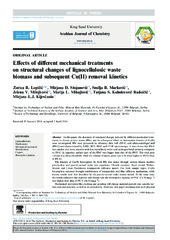Приказ основних података о документу
Effects of different mechanical treatments on structural changes of lignocellulosic waste biomass and subsequent Cu(II) removal kinetics
| dc.creator | Lopičić, Zorica | |
| dc.creator | Stojanović, Mirjana | |
| dc.creator | Marković, Smilja | |
| dc.creator | Milojković, Jelena V. | |
| dc.creator | Mihajlović, Marija L. | |
| dc.creator | Kaluđerović-Radoičić, Tatjana | |
| dc.creator | Kijevčanin, Mirjana | |
| dc.date.accessioned | 2021-03-10T13:57:11Z | |
| dc.date.available | 2021-03-10T13:57:11Z | |
| dc.date.issued | 2019 | |
| dc.identifier.issn | 1878-5352 | |
| dc.identifier.uri | http://TechnoRep.tmf.bg.ac.rs/handle/123456789/4100 | |
| dc.description.abstract | In this paper, the character of structural changes induced by different mechanical treatments to Prunus persica stones (PSs), and its subsequent effect on biosorption kinetics of Cu(II) were investigated. PSs were processed in vibratory disk mill (PS-V) and ultra-centrifugal mill (PS-C) and characterized by XRD, BET, SEM and FTIR spectroscopy. It was shown that PS-V was smaller and more reactive with less crystallinity index and hydrogen bond intensity compared to PS-C. In opposite, surface area of the PS-C was bigger than that of the PS-V. The total pore volume was about threefold, while the volume of micro pores was 9.29 times higher in PS-Cs than in PS-Vs. The kinetics of Cu(II) biosorption by both PSs was tested through various kinetic models: pseudo-first and pseudo-second order rate equations, Elovich equation, Boyd model, Weber-Morris and Urano-Tachikawa intraparticle diffusion model. For both sample types, Cu(II) biosorption occurred through combination of intraparticle and film diffusion mechanism, while kinetic results were best described by the pseudo-second order kinetic model. At the same time, the results indicated that together with kinetic rate the biosorption capacity of PS-C (21.20 mg g(-1)) was higher than that of PS-V (16.30 mg g(-1)). Mechanical activation like crushing and grinding will change material particle size, specific surface area and porosity, as well as its crystallinity. However, this paper elucidates that such physical structural changes will impact on heavy metal ions removal efficiency. This investigation suggests that the type of size reduction in lignocellulosic biosorbent preparation plays a very important role in overall biosorption performance, so it should be carefully considered every time when the mechanical treatment of material is necessary to be applied. | en |
| dc.publisher | Elsevier, Amsterdam | |
| dc.relation | info:eu-repo/grantAgreement/MESTD/Technological Development (TD or TR)/31003/RS// | |
| dc.rights | openAccess | |
| dc.rights.uri | https://creativecommons.org/licenses/by-nc-nd/4.0/ | |
| dc.source | Arabian Journal of Chemistry | |
| dc.subject | Lignocelluloses | en |
| dc.subject | Peach stone | en |
| dc.subject | Mechanical treatment | en |
| dc.subject | Modification | en |
| dc.subject | Copper | en |
| dc.subject | Biosorption kinetics | en |
| dc.title | Effects of different mechanical treatments on structural changes of lignocellulosic waste biomass and subsequent Cu(II) removal kinetics | en |
| dc.type | article | |
| dc.rights.license | BY-NC-ND | |
| dc.citation.epage | 4103 | |
| dc.citation.issue | 8 | |
| dc.citation.other | 12(8): 4091-4103 | |
| dc.citation.rank | M21 | |
| dc.citation.spage | 4091 | |
| dc.citation.volume | 12 | |
| dc.identifier.doi | 10.1016/j.arabjc.2016.04.005 | |
| dc.identifier.fulltext | http://TechnoRep.tmf.bg.ac.rs/bitstream/id/1828/4097.pdf | |
| dc.identifier.scopus | 2-s2.0-84964679930 | |
| dc.identifier.wos | 000504900300221 | |
| dc.type.version | publishedVersion |

